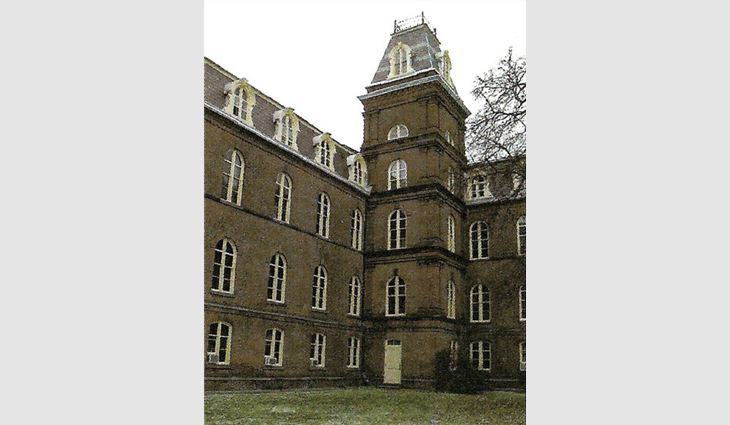 Photo courtesy of Vassar College, Poughkeepsie, N.Y.
Photo courtesy of Vassar College, Poughkeepsie, N.Y.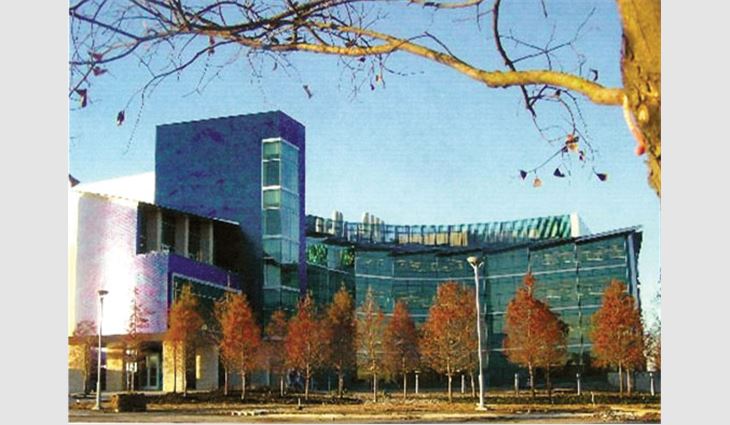 Photo courtesy of Architectural Building Components, Houston
Photo courtesy of Architectural Building Components, Houston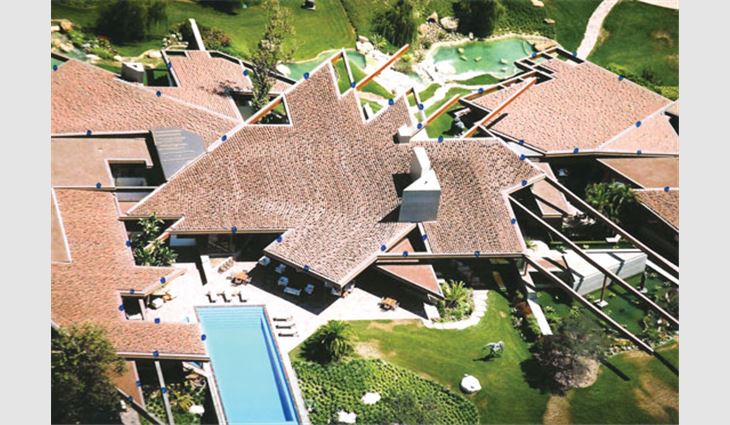 Photo courtesy of Keystone Roofing Inc., Oceanside, Calif.
Photo courtesy of Keystone Roofing Inc., Oceanside, Calif.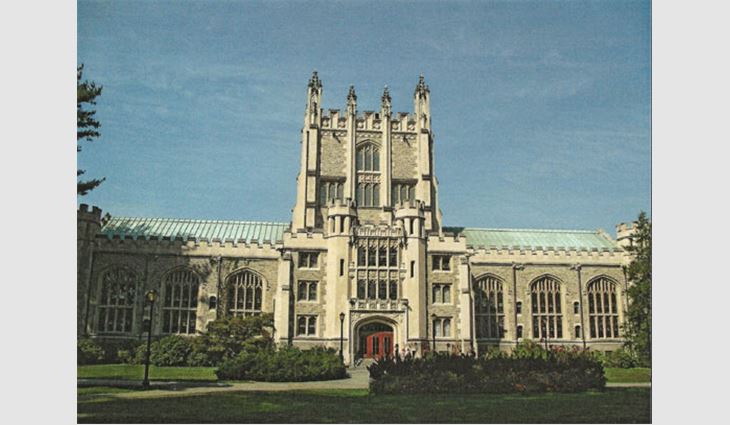 Photo courtesy of Levine & Co. Inc., Ardmore, Pa.
Photo courtesy of Levine & Co. Inc., Ardmore, Pa.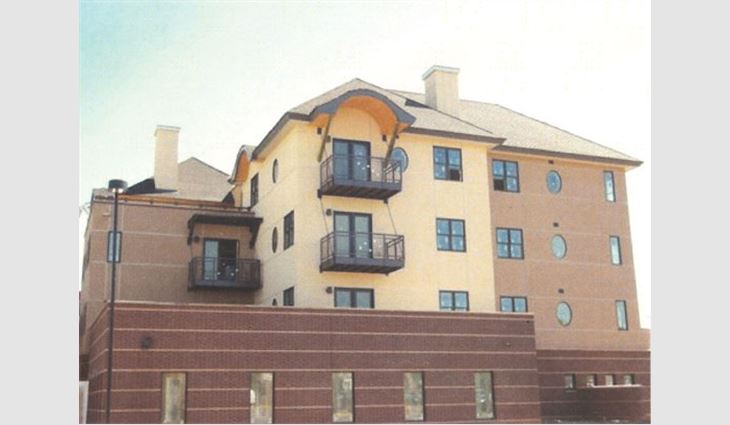 Photo courtesy of Brent's Place, Denver
Photo courtesy of Brent's Place, Denver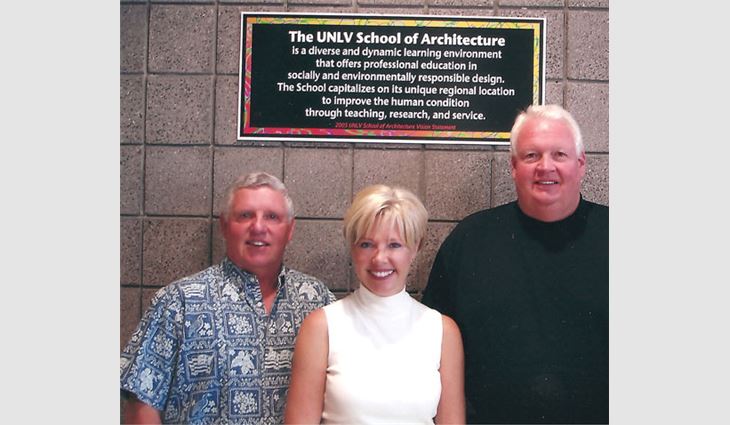 Photo courtesy of Commercial Roofers Inc., Las Vegas
Photo courtesy of Commercial Roofers Inc., Las VegasGold is associated with excellence. It often is the highest medal awarded for a NRCA honors members that have made exceptional contributions to the roofing industry through its Gold Circle Awards program. These awards are bestowed for the year's best projects.
NRCA members are nominated by their peers for meeting standards of achievement in four categories: outstanding workmanship, innovative solutions, service to the community and service to the industry.
NRCA's 14th annual Gold Circle Awards were presented during NRCA's 122nd Annual Convention in Las Vegas. This year, 26 nominations were received for projects completed between June 1, 2006, and May 31, 2008.
Following are profiles of the winning projects.
Gold Circle Award category: Outstanding workmanship—steep slope
Recipient: Hayden Building Maintenance Corp., West Nyack, N.Y.
Project: Vassar College Main Building north and south tower restorations, Poughkeepsie, N.Y.
Roof system type: Slate
Vassar College was founded in 1861 as one of the U.S.' first womens colleges. It became coeducational in 1969 and is ranked No. 11 among liberal arts colleges by U.S. News & World Report.
Vassar College's Second Empire-style Main Building, the second building constructed on Vassar College's campus, was built in 1861. It housed the entire college, including dormitories, libraries, classrooms and dining halls. The building's first and second floors now house campus administrative offices, and the third, fourth and fifth floors house student rooms.
Vassar College's Main Building was named a National Historic Landmark in 1986.
In 2008, the college decided to replace the building's deteriorating copper and slate roof system. Hayden Building Maintenance learned about the needed restorations through Vassar College, for whom Hayden Building Maintenance had previously performed work.
"We were asked to remove the old slate and copper and install new copper and slate to match," says Kevin McLaughlin, president of Hayden Building Maintenance's slate and copper division.
Roofing work at Vassar College began in May 2008.
Historic restorations
Hayden Building Maintenance reroofed the Main Building's low-slope areas, but special attention was paid to reroofing the building's north and south towers.
"The towers' existing roof systems consisted of a wood deck, North Country Slate shingles with hand-cut green bands and 20-ounce built-in copper gutters," McLaughlin says. "The roof systems also featured 20-ounce copper dormer tops and flashing interwoven copper caps at hips, as well as iron balustrade."
First, Hayden Building Maintenance carefully removed the iron balustrade. The salvaged pieces would later be prepped, primed, painted and reinstalled. Next, all slate was removed down to the wood. Dormers, the metal skirt and the copper-lined gutter also were removed.
All rotted wood from the deck was removed and replaced with new wood. Hayden Building Maintenance then installed new copper drip edge metal with an integral cant at the eave and new North Country Slate shingles.
Existing copper hip flashings and rotted upper wood molding also were replaced. New copper hip flashings were installed to match the originals, interwoven with each slate course.
Finally, Hayden Building Maintenance installed new dormers and replaced the copper gutters.
To protect its eight-member crew, Hayden Building Maintenance installed scaffolding around the towers' perimeters during roof system repairs.
A job well-done
Hayden Building Maintenance completed work at Vassar College in December 2008. And those involved are pleased with the outcome.
"This project ended with a great result," says Arthur Fisher, Vassar College's project manager.
Gold Circle Award category: Outstanding workmanship—low slope
Recipient: KPost Co., Dallas
Project: University of Texas at Dallas' Natural Science & Engineering Research Laboratory, Richardson
Roof system type: Standing-seam metal
The University of Texas at Dallas enrolls about 15,000 students and is the largest public research university in the University of Texas system. The university's main campus is located in Richardson, a suburb just north of Dallas.
In 2004, the university decided to add three buildings to its campus to increase its research capacity and help it become one of Texas' "Tier One" research institutions. The more than 300,000 square feet of new building space was to be constructed between 2004 and 2006. And the expansion plan centered on the construction of an $85 million Natural Science and Engineering Research Laboratory at the campus's north end.
KPost learned about the project from Balfour Beatty Construction Group Inc., Dallas, the project's general contractor, in July 2004 and submitted a bid it prepared from schematic drawings. The bid proposed installing an exposed steel standing-seam roof system and stainless-steel fin-shaped structures—which ultimately were referred to as "beaks"—fabricated in 10- to 30-foot runs projecting 24 inches from the standing-seam roof system and ending in sharp edges.
Piece by piece
KPost started work at the Natural Science and Engineering Research Laboratory March 6, 2006.
"The roof system consists of 12 roof areas and totals about 15,000 square feet," says Steve Little, KPost's president. "The roof areas were to tilt and fade into one another at 3-in-12 (14-degree) slopes, varying slightly on each roof area."
KPost began by installing a metal deck covered with a layer of 1 1/2-inch-thick polyisocyanurate insulation board, 3-inch-thick polyisocyanurate insulation board and 1/2-inch-thick DensDeck® roof board mechanically fastened with 16 fasteners per board. The insulation and roof board then were covered with Grace Ice & Water Shield® underlayment.
The company then installed an exposed red iron substrate. However, KPost encountered some difficulties at this point.
"The substrate did not line up with the finished roof deck elevation, so we had to redesign the dry-in of the substrate with two other trades—the steel workers and framers," Little says. "When their work was completed, we installed two layers of 3/4-inch-thick plywood to get the substrate somewhat straight and then covered the entire beak structure."
The membrane then was waterlapped under the Ice & Water Shield on the sloped metal deck.
After ensuring the metal deck and substrate were watertight, KPost turned to the task of installing the beaks.
"The beaks were designed through several mock-ups and installed in place before the final fabrication," Little says. "To achieve the knife-edge look, we tried and tested several options. The final design consisted of 22-gauge brushed stainless steel with 20-gauge clips to hold the beak portions in place."
KPost subcontracted NOW Specialties Inc., Carrollton, Texas, to provide the soffit panels.
"NOW Specialties fabricated 22-gauge brushed stainless-steel aluminum composite panels that we installed to meet the beaks," Little says. "Each of these pieces were field-measured and custom-made to meet the building lines, and each of the beaks and soffit panels align with the window mullions and building lines. Each corner had to be customized to achieve the various angles as the system came together."
KPost then covered the beaks with a 45-mil-thick EPDM membrane. Before installing an Architectural Building Components 200 Series 24-gauge 18-inch-wide Galvalume® Plus™ standing-seam metal roof system with 2-inch high-locked seams, KPost installed all 22-gauge stainless-steel soffit panels, 24-gauge stainless-steel rise-wall flashings and beaks. The ends of the corner beaks were welded into place.
"Each roof deck sloped in at least two directions in most cases because of the building's structure," Little says. "The complicated part was tying in the stainless-steel beaks to the standing-seam metal roof system. The standing-seam roof stopped 2 feet short of the roof surface exterior, making each tie-in point unusual."
In addition, the roof's slope to the beaks required different types of flashing conditions.
"Depending on the slope of the roof panel and deck, some laps were over the top and some had to be under the panel system," Little says. "A flashing condition could change up to two times per standing-seam panel."
Additionally, some flashings had to be tested for watertightness before other trades at the job site could install finished wall panels, windows or steel support structures.
Some hurdles
KPost took some precautions for this job.
"The job required 100 percent tie-off," Little says. "For the areas where we installed Red Iron Steel Building substrate, our crews worked from two man-lifts and off the substrate. We installed a restraint system per Occupational Safety and Health Administration guidelines and required personal protective equipment along several cable systems tied back to the structure."
Additionally, KPost had to work around some other trades—specifically during exterior metal wall shingle installation.
"Because the building is curved, the access area was limited," Little says. "Also, the site was quite muddy and all roofing materials needed to be lifted to the roof deck by crane. The beaks and soffits were lifted individually inside the two man-lifts."
The original site was 10 to 15 feet below finished elevation and also muddy.
"We installed the exterior portion from the lifts in this area," Little says. "As the building was finished, we had to work around the general contractor filling in the front elevation where all our work was taking place."
And the project took longer to complete than was originally anticipated.
"The project was extended because of many variances with design; terrain, which was constantly changing; and the many trades working around us," Little says. "Our crew varied from 8 to 12 people based on the amount of area ready for installations, and we had many days where we only had two or three people on-site. Drying-in of the beaks required small crews because of equipment access."
A complex success
KPost completed work July 18, 2007, and a weathertight warranty was issued Sept. 18, 2007. And despite the numerous challenges and obstacles the project presented, KPost considers the final product a huge success.
"The building's finished elevations, landscapes and design are unique and beautiful," Little says.
Gold Circle Award category: Innovative solutions—new construction
Recipient: Keystone Roofing Inc., Oceanside, Calif.
Project: Private estate, Southern California
Roof system type: Clay tile
In January 2005, Mark Katona, chief financial officer of Keystone Roofing, was approached by the owner of a recently constructed 45,000-square-foot estate in Southern California. The owner asked that Keystone Roofing work with the estate's general contractor and architect to design and install a unique roof system on the building.
The Frank Lloyd Wright-inspired estate has six wings and a 60-car garage under the home for the owner's Ferrari collection. The estate's unique appearance features various roof slopes and tapered clerestory windows.
"The owners wanted a one-of-a-kind roof system design that would complement the home," Katona says. "Given the complexity of the building's geometry, all roof areas posed an array of challenges that would defy conventional practices."
Atypical tile
To meet the owner's request, Redland Clay Tile roof tiles were molded into pan shapes specifically for the project. Special molds were made, used and broken so no one would be able to replicate the shapes.
"A Redland Clay Tile installation typically would include about 175 tiles per 100 square feet of roof system," Katona says. "But for this project, the architect basically demanded we throw out the installation book. According to the architect's vision, we compressed about 600 tiles per 100 square feet.
"The tile roof is strictly an aesthetic fea ture of this project because of its totally unconventional installation requirements," Katona continues.
Challenges
Before the tiles could be installed, Keystone Roofing had to figure out how to make the unconventional tile application watertight.
"Because of the massive number of tiles that were installed, none of which are technically watertight, as well as the tiles' serpentine pattern, which reduces water flow, we needed to develop unprecedented waterproofing techniques," Katona says. "We essentially needed to divert or skew water from its natural gravitational flow down each serpentine pan area of roof. Because of the serpentine pattern, the water flow needed to be channeled to the tile pans, especially during heavy rain."
Keystone Roofing installed a six-layer GAF Materials polymer-modified bitumen roof system on the estate. The roof was picture-framed with 37-ounce copper trim flashing and outrigger beam cladding that is twice the thickness called for in standard residential requirements. Additionally, 37-ounce copper perforated drains were installed.
"Every piece of 37-ounce cladding was hand-crafted on-site," Katona says. "A stainless-steel Twisted Wire Tyle Tye® System was installed to hold every tile in place."
Keystone Roofing's crews varied from four to 16 workers per day depending on what work was being done. Workers wore harnesses with rope-grab systems, and the job was completed with no injuries.
Sweet success
Keystone Roofing completed work on the estate's roof system in March 2007.
"With more than two years in production, we were never given a timeline to adhere to," Katona says. "We knew it would be a job that needed to be worked on with many other trades until it was done properly."
And the finished product, which earned Keystone Roofing its fourth consecutive Gold Circle Award, is nothing short of magnificent.
"Far beyond the roof's functionality, we feel we have achieved something special that is a thing of beauty," Katona says. "There are few projects of this magnitude in the world. We are privileged to have been selected for this important project."
And Katona enjoyed the process as much as the finished product.
"The homeowners are some of the most humble and pleasant people I've had the pleasure of doing business with," Katona says. "I am grateful for the opportunity to bring them this prestigious award. It truly is a gold standard project for the ages."
Gold Circle Award category: Innovative solutions—reroofing
Recipient: Hayden Building Maintenance Corp., West Nyack, N.Y.
Project: Vassar College Thompson Library, Poughkeepsie, N.Y.
Roof system type: Copper, fluid-applied elastomeric membrane
Vassar College's Frederick Ferris Thompson Memorial Library—the college's main library—was constructed in 1905. The Perpendicular Gothic building was designed by Allen & Collens, a Boston-based architectural firm, and features a central tower, three long wings and an entrance hall.
The building has a 6,400-square-foot copper roof system surrounded by crenellated limestone parapets. Nine-foot-wide built-in gutters lie at the eave of each of the building's wings.
Because of its age and infrequent and inappropriate maintenance during the years, the library's roof system began leaking many years ago. In 2007, the college decided to have the roof system properly rehabilitated. Hayden Building Maintenance was chosen to perform the repairs.
Long-needed repairs
In March 2007, Hayden Building Maintenance began its work at the library by mapping the roof system's deficiencies.
"Layer upon layer of bituminous membrane had been added to the gutters—nearly 4 inches of soaking wet material would eventually be removed," says Jeffrey Levine, president of Levine & Co. Inc., Ardmore, Pa., the project's roof consultant. "Punctures, open seams, wear holes and failed flashings in the batten-seam copper roof system had gone unattended or been covered with multiple layers of mastic.
"Perhaps worst of all, the gutters' original outlet tubes, which once had drained through the mouths of gargoyle-like creatures expertly carved into the limestone parapets, were abandoned, raised and indelicately placed in cores above the now nonfunctional beasts," he continues.
Hayden Building Maintenance repaired each puncture, open seam, hole, slit and nail pop in the batten-seam copper roof system by soldering copper patches in place. Additionally, problems with embrasure flashings at the parapets, counterflashings and batten end caps were repaired or replaced.
But it was the 260 feet of 9-foot-wide gutters representing more than 2,350 square feet of the roof's surface area that presented the main challenge.
A new solution
The gutters' existing bituminous membrane system had failed partly because it was unable to withstand New York's harsh winter conditions. So Hayden Building Maintenance considered other roof system options.
"EPDM, though a common 'go-to' solution, is not really designed for gutter troughs, does not handle inside corners and plane changes well and rarely lasts more than 10 years in locations such as New York," Levine says. "Flat-seam copper would have been a technically feasible choice with the benefit of a 50-year service life, but at what cost? Needless to say, way too much."
Hayden Building Maintenance eventually selected a fluid-applied membrane roof system to meet the college's budget and long-term requirements.
Installing the system
Hayden Building Maintenance removed all existing membranes and flashings down to the gutters' wood framing members. Crew members then replaced the deteriorated framing and installed new sloped gutter sheathing.
Next, mastic residues were removed from the parapet walls and a Liquid Plastics 3-ply DECOTHANE sp system was applied. And because the batten-seam copper roof system was to remain in place, Hayden Building Maintenance installed an intricate copper apron flashing to bridge the interface between the batten-seam roof and the new gutter liner's top edge.
New copper and lead-coated copper counterflashings, parapet embrasure flashings, gussets and turret door threshold flashings were installed, as well.
Levine says: "Deteriorated mortar joints located behind existing flashings were raked out and repointed before installing the new flashings."
Restoring the gargoyle outlet tubes was one of the project's main goals because it would greatly enhance the building's historic integrity. Hayden Building Maintenance performed several test openings to establish elevations and determine the likelihood of using the original gutter outlet locations.
"We removed two or three abandoned tubes from each gargoyle and carefully removed the cementitious fill in the gargoyles' mouths," says Kevin McLaughlin, Hayden Building Maintenance's vice president of operations. "We then fit new outlet tubes made of copper pipe with elbows at the top and bottom to ensure alignment with the gargoyles' mouths."
Overflow scupper tubes then were placed in the holes that had been cored when the outlet tubes were raised previously.
"This fluid-applied elastomeric roof system has an expected service life of 20 years, after which it can be cleaned, primed and recoated to extend its service life another 10 to 15 years," Levine says.
Parapet walls were installed around the building's perimeter to ensure worker safety during the project.
Former glory restored
Hayden Building Maintenance completed the project in November 2007 within budget constraints, and the library was able to remain fully functional during the nine months of construction.
Gold Circle Award category: Service to the Community
Recipient: Colorado Roofing Association, Denver
Project: Brent's Place, Denver
Roof system type: EPDM, shingle
Brent's Place is a facility located near The Denver Children's Hospital that provides individual, fully furnished apartments for children undergoing cancer treatment and their families. The facility was developed in 1998 as a program of The Brent Eley Foundation, which was founded in 1997 by Donn and Linda Eley as a tribute to their son, Brent, who passed away from cancer when he was 15.
Brent's Place provides care for its patients—all of whom are immune-compromised and at risk of infection—by maintaining a "safe clean" environment, which means the facility is free from exposure to those who may inadvertently carry infection. This is especially important for patients healing from bone marrow or stem cell transplants. Patients are accepted on a first-come, first-served basis, and the facility offers activities, outings, group meals and other amenities for the patients and their families.
When the Denver Children's Hospital moved to a new location, Brent's Place also needed to move to be close to the hospital.
In April 2007, Donn Eley approached Curt Boyd, founder of Aurora, Colo.-based Academy Roofing and former president of the Colorado Roofing Association (CRA), to request Academy Roofing submit a discounted bid to install a roof system on the new four-story building. Boyd, in turn, invited Eley to meet with CRA's board of directors to make a formal request. The board eventually voted to donate all labor and materials for the roof system.
Some preplanning
Before CRA could begin work at Brent's Place, it needed to secure commitments from its members to donate the required materials and labor. The CRA Community Service Committee issued a request, and 34 CRA member contractors, manufacturers and suppliers volunteered.
One roofing contracting company, D & D Roofing Inc., Commerce City, Colo., volunteered to be the supervisory coordinator of all the volunteers for Pinkard Construction, the project's general contractor.
"D & D Roofing became the 'contractor of record,'" says Greg Ham, regional product manager for Allied Building Products, one of the volunteer companies. "It was the only company that actually signed a contract with Pinkard Construction. Over time, the contract was devalued because we were able to provide more in-kind donations of labor and materials."
A kick-off meeting was held, and volunteers reviewed subcontracts and insurance requirements. Contractors also were informed about the stringent safety requirements that would be in place, which included a mandatory first-day on-site orientation for all contractors and their crews.
Roofing for charity
Before work began, the roof was divided into sections and contractors were assigned individual work areas with an overall pre-dry-in by one company.
The four-story building has several roof areas and required two roof system types. On the low-slope roof areas, the crews installed 125 squares of EPDM. Additionally, 1,200 square feet of plaza pavers were installed, and reflective coatings were applied.
On the roof's 10-in-12 (40-degree) sloped areas, crews installed 110 squares of shingles, as well as barrel dormers and ridge vents. More than 500 feet of gutters and downspouts, scuppers and required flashings were installed, as well as 580 feet of metal fascia.
"As the project continued, our scope increased further," Ham says. "For example, in the original agreement, we hadn't offered to install the fascia."
And safety was highly stressed throughout the project.
"Everyone had to wear hardhats, orange illuminating vests and safety boots," Ham says. "Workers wore harnesses, and warning lines were used on the low-slope roof system areas 6 feet from the perimeter."
Complications
Because of the job's size and the number of companies involved with the work, it was difficult to coordinate some of the job's aspects. For instance, work progress had to be constantly monitored to schedule the 18 volunteer companies and maintain construction continuity.
"To my knowledge, there weren't any difficulties from a scheduling standpoint," Ham says. "But it was challenging to coordinate all the subcontractors' schedules with the arrival of all donated roofing materials."
Additionally, an investigation by the city presented a small dilemma.
"One of the city investigations determined 10 additional overflow scuppers were needed," Ham says. "This was after the building's walls were in place and all inside and outside finishes were installed. But this only presented us with a slight headache."
A rewarding endeavor
Work at Brent's Place was completed in December 2008, and those involved are proud of the project, which included hundreds of volunteers performing a total of almost 1,400 hours of work.
"We didn't have concerns about getting the donated materials, but we were really concerned about all the volunteer contractors completing the work on time, especially during summer when companies have a lot of paying work," Ham says. "But the project went off without a hitch, I think, because of the kindness and generosity of the contractors and CRA."
Gold Circle Award category: Service to the Industry
Recipient: Commercial Roofers Inc., Las Vegas
Project: University of Nevada, Las Vegas Scholarship Program
Not all NRCA Gold Circle Awards are given for exemplary roofing projects. This year, for example, the Service to the Industry Award was presented to Commercial Roofers Inc. for its substantial commitment to the University of Nevada, Las Vegas (UNLV).
In 1997, Commercial Roofers established a $10,000 scholarship fund for UNLV's School of Architecture. Each year for 10 years, a $1,000 scholarship was to be awarded to a third- or fourth-year architectural student in the university's Construction Technologies class.
Scott Howard and Dennis Conway, both principals of Commercial Roofers, spend a day each year visiting the class to speak about roofing, its importance to the success of all buildings and the roofing industry as a whole. Each student is asked to design a mock building with emphasis on the roof plan, and the projects are judged by the class instructor and two UNLV professors with Howard or Conway observing. The competition winner receives the scholarship.
In 2008, Commercial Roofers renewed the scholarship and increased its commitment to $15,000 to be given annually in the amount of $1,500.
Continuing tradition
As they do every year, the 2009 Gold Circle Award winners demonstrated exemplary commitment to dedication, innovation and charity in the roofing industry. NRCA looks forward to nominations for the 2010 Gold Circle Awards, which will be presented during NRCA's 123nd Annual Convention in New Orleans Feb. 20-24, 2010.
For more information about NRCA's Gold Circle Awards, log on to www.nrca.net or contact Chrystine Hanus, NRCA's director of meeting services, at (800) 323-9545, ext. 7522.
Ashley St. John is Professional Roofing's associate editor.
NRCA awards safety
NRCA presented its Gold Circle Safety Award to Midland Engineering Co., South Bend, Ind., for its work at The Ascent at Roebling's Bridge, a condominium complex in Covington, Ky.
Midland Engineering installed 15,000 square feet of fully adhered Sika Sarnafil vinyl membrane on the newly constructed building, which features a slope of 9-in-12 (37 degrees) at heights of 150 to 300 feet. The company designed and installed a safety system consisting of numerous tie-off davits to support operations.
Safety Awards are given for accident-free projects where public protection challenges were at the forefront of job elements and dominated the scope of work.
COMMENTS
Be the first to comment. Please log in to leave a comment.